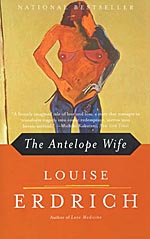
![]() Stella Atrium
Stella Atrium
2/16/2013
![]()
Louise Erdrich has written a series of novels about a Native American extended family trapped in poverty and fear on the reservation and in Minneapolis (called Apple Town due to the vowel sounds). In The Antelope Wife, revolving narrators bead together the events apparently to bind patterns over generations – fates of twins, lost babies, lustful wives. Since the level of diction of each narrator is identical with lazy grammar, interjected native words, and self-centered vision, the use of he-she-they gets confusing for relations among the cousins.
My reading of The Antelope Wife was different from other reviewers who took the first narrator in chapter one as the center. I found the central character to be Cally who struggles to find meaning in the advice, myths, strange gestures, broken dreams of her parents-stepfather-cousin-grandmas-ancestors. The details Erdrich presents of their disassociated lives are unsparing and often funny. For example, Cally wonders about the choices of a cousin who pre-salts her food since salting before tasting is an indication of general dissatisfaction with life.
Cally moves to Minneapolis and works in the family bakery, asking each client if she has seen the twin grandmothers who are Namers and have a reputation among the tribes. The grandmothers visit much later for Christmas while listing all their digestive complaints. Cally's main frustration is with a distant mother who seems tortured by a lustful past and troubled by judging ancestors. After her botched second wedding, this Calico Wife cooks for hungry ghosts so the ancestors and a lost daughter will feel full and leave.
There's no stream of current events from TV or even military service to anchor the reader, and no structured reasoning for any character gained from books or technical training. The stepfather tries to duplicate a cake made by an outsider without recipe or reference to books. Each character tries to divine meaning from the ignorant acts of others – willfully ignorant as though the Native Americans refuse to learn from the larger culture for fear of losing spiritual contact with the prairie.
Throughout the reading, I was often reminded of the Mexican novel Like Water for Chocolate by Laura Esquivel that has a central love story, a fear of vengeful ancestors, and an ironic take on the fates of family members. Recipes were said to hold the spirits of ancestors, and service to family was an organizing theme.
But Erdrich offers short vignettes, often from the POV of non-family members, even a dog, as part of her beading, constructing a unique and gritty backstory tied to the land. The effect is like a child's watercolor as viewed through a window streaked with rain. Although the colors were once strong, the current outlines are blurred and runny, made void of the sought-after deeper meaning.
Since this story was in the cache for the Worlds Without End 2013 Women of Genre Reading Challenge, I wondered again at the loose categories for genre writing. The unreliable narrators and the Native American stories about troubling spirits don't constitute a genre subcategory. I would rather shelf this novel and all of Louise Erdrich in literature, although Like Water for Chocolate is often shelved with Ethnic Studies.